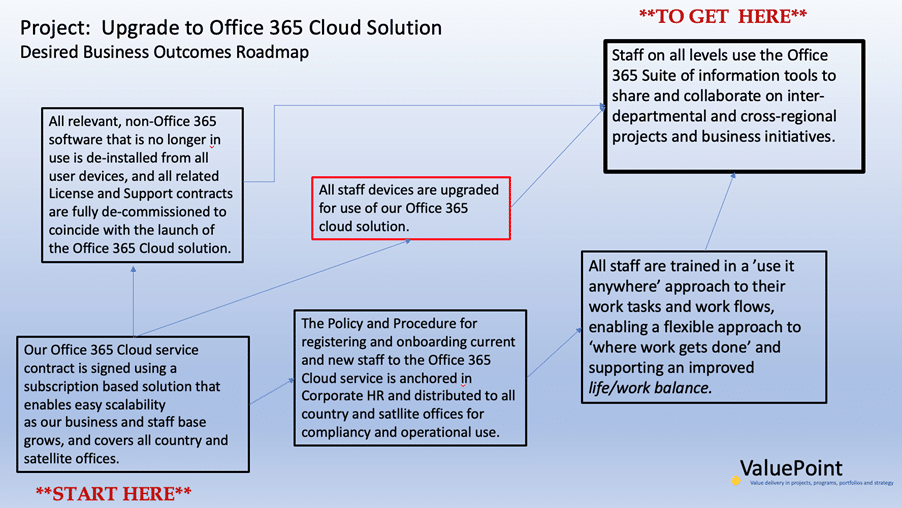Dramatically Improve Project Deliveries Using Outcomes Roadmaps
ValuePoint works with the TOP methodology as part of our approach, including the TOP Value Equation: a groundbreaking Business Value Delivery Management methodology that consists of a structured and intuitive process and tool set to help organisations identify project benefits and business value that in turn drive more successful project deliveries.
Chances are you clicked through on a link to come read more about why an outcomes roadmap optimises your project delivery. Thanks for that!
Recap & background
If you haven’t read Part One, please do so here: https://valuepoint.dk/project-success-re-imagined-the-power-of-business-outcomes/.
In short, using business outcomes frames your project in ‘impact to business’ terms and defines with specificity and in plain language how a project will change operations – the ‘how we do things’ – to improve your organisation. It moves a project’s scope from being a technical delivery to becoming a change in how the organisation operates.
Defining business outcomes is done in a workshop format that includes the stakeholders who are in the best position to deliver a successful project. Having this direct input and engagement heightens commitment exponentially.
It’s not enough, however, to create a list of business outcome statements – that’s the start, but there’s more to it than that.
To increase the capability to:
– optimise a project’s delivery efficiency
– reduce the risk of project scope creep
– reduce the risk of budget overrun (better cost control)
– reduce the risk of unnecessary re-work (better resource usage)
– align the project team and stakeholders (from Steering Committee to Portfolio to Strategy owners)
– make your project purpose easily understood to the organisation at large
To do all THAT, you create an outcomes roadmap that logically and graphically demonstrates the best path for a successful and streamlined project delivery.
The Outcomes Roadmap
We use a simple, generic project as an example.
Say you have an initiative requiring the installation of Office365 onto all staff devices globally. For some this sounds like an IT project, but when you’ve defined your business outcomes it takes on a different delivery scope all together.
There are any number of business and operations considerations that may come into play during the Outcomes Definition Workshop, such as:
– sourcing requirements and the purchase process
– decommissioning of current licenses
– installation of Office365 onto staff devices
– registering and onboarding new staff
– policy and procedure changes
– communication
– compliancy planning
– staff training
– impact to hybrid working flexibility
– ultimate purpose and impact of the project
It’s clear from the above that when you start thinking in business and operations terms, a successful project delivery takes on a whole meaning. Scope shifts from a technical delivery to a business delivery, as can be seen here:

Note that the IT workstream is in the highlighted box in the center. Project success is now understood as far more than a technical delivery.
Why This is Important
The creation of the roadmap is used for these purposes:
- to get the input and alignment of stakeholders
- to provide specificity at the earliest stages of a project’s analysis phase
- the outcomes are used to identify the project benefits (upcoming article)
- the outcomes are used to identify the needed change activities (upcoming article)
- the outcome’s delivery activities are used to construct an accurate cost picture
- the roadmap is used as the key component in the project business case
- the roadmap is used as a key communication tools on a project, showing the agreed outcomes delivery sequence until reaching the final, overall desired business outcome to create alignment among participants, stakeholders and decision makers on what the project is really about
- the roadmap is used as a primary reporting tool in Steering Committee meetings for demonstrating project progress
Additionally, when used in the execution phase it takes delivery accountability to a new level of granularity: each outcome is owned by an appropriate stakeholder. Project Managers coordinate, assist and report on outcome deliveries, but the ultimate mover is the designated stakeholder. Ownership and accountability is transparent and part of the natural flow of a project delivery.
At portfolio level, outcome roadmaps are used for apple-to-apple comparisons of potential projects, project prioritisation, and for following projects in progress. It is the standard for framing projects and serves to shift organisation focus to a business value delivery mindset.
And when taken to the execution of an organisation’s strategic initiatives, project outcome roadmaps are linked directly to strategic outcomes, given a transparent connectivity between strategy and the work being handled at the individual project level.
Want to go even deeper? Let’s talk 🚀

